My first sight was Taliesin West, the winter working complex of architect Frank Lloyd Wright, located in northern Scottsdale. Although I had been to another house of his - the original one in Oak Park, Illinois - this one has a completely different character to fit the surroundings.
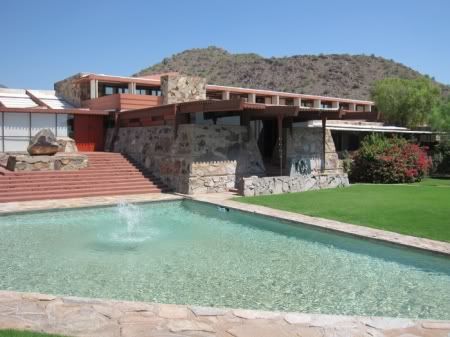 Excerpted from my caption for Facebook:
Excerpted from my caption for Facebook:"This is the southern yard. It was the front yard when the complex was built, with excellent views of Scottsdale and Phoenix, but when a power line destroyed the view, and Wright was unsuccessful in getting authorities to remove the power line, he re-oriented the complex toward the mountains behind, and this became the back yard.
"The structures originally had no glass, only canvas roof to protect the interior from the elements. The pool in front was used to wet and stretch the canvas before installation whenever Wright and his apprentices moved in every autumn. After several years, glass was installed, and today, the curators are still looking for materials that have the translucent qualities of canvas while being more leak-resistant. (Wright buildings are notorious for leaks anyway.)
"Another reason for the pool: emergency fire suppression. The original Taliesin, in Wisconsin, had been gutted by two fires - 1914 and 1925. The 1914 fire was an arson by one of Wright's employees, who had left only one exit unlocked, and axed to death all who attempted to escape, including Wright's then-mistress and her two children."
Also of note: Wright's favorite color since childhood was red, and as a result, red is liberally used throughout the building, especially on wooden and steel elements.
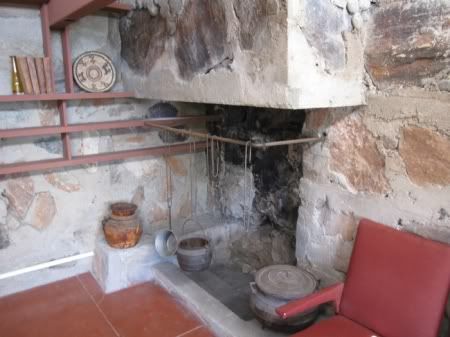 Also from my Facebook caption:
Also from my Facebook caption:"This fireplace is located in Wright's bedroom.
"Wright had grown up in the late 19th Century, when fireplaces were the centerpiece of any room, so he insisted on having a fireplace in every room here. But he kept them cantilevered like this, because he hated the boxy Victorian architecture that was popular in his day."
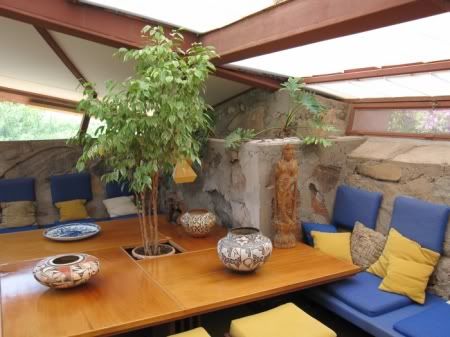 Again, my Facebook caption:
Again, my Facebook caption:"The Garden Room, one of the larger rooms of Taliesin West.
"That's a lovely statue - while my guide described it as a Buddha, it looks more like a Kwan Yin to me. Frank Lloyd Wright had a Baptist minister as his father, though he never had much of a contact with him, and his spirituality resembled that of his Unitarian mother, not subscribing to a specific religious belief but being enamored of many divine concepts. He certainly loved collecting Buddhist art."
This is indeed a very nice, airy place to come across my transgender matron saint. Even more so, because Wright is well known for his "compression and relaxation" philosophy, which forces people to walk through very constricting passageways to enter a relatively open interior. Such passageways have notoriously low ceilings, at most 6' high, interesting because Wright was by no means a short man (5' 8 1/2", just like me, and even by his contemporary standards, respectable).
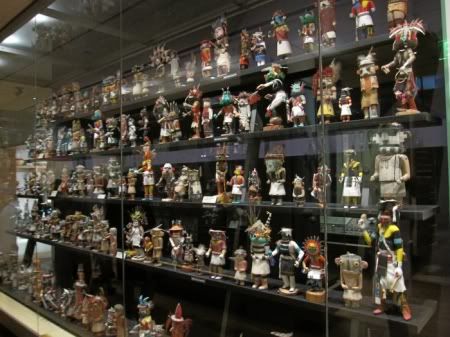 I moved on to Heard Museum north of downtown Phoenix, which turned out to be a 25-minute drive from the remote Taliesin west. My Facebook caption:
I moved on to Heard Museum north of downtown Phoenix, which turned out to be a 25-minute drive from the remote Taliesin west. My Facebook caption:"These figurines are from the Hopi tribe, and represent katsinas. A katsina, in Hopi spirituality, is a spirit messenger, who may represent natural forces or dead ancestors.
"This museum serves as not just an art display, but a comprehensive introduction to all American Indian tribes of Arizona and New Mexico, complete with their basic spiritualities and languages.
"There is also an exhibit on the Indian School system, which was created in the 1870s to "civilize" the Native Americans by forcibly taking their children away from home, and indoctrinating them in English-speaking white culture and Christianity. I could even take my own exam notebook, take an Anglo-American name forcibly given to me, and do some homework that the Indian children would have had to do; for example, if caught missing Grandma's meals, I'll have to write "Indian food is bad" in the notebook in proper cursive Roman alphabet, and if caught speaking my native language, I'll similarly have to write "I will speak English only." While Indian Schools still exist today, their focus since the 1930s has been more on preserving Native American cultures, rather than destroying them, and are now seen as the United States' reparation to the Indian tribes whose lands and livelihoods it had disrupted."
Back when I was actually living in Arizona, I never bothered to come here, but with a better understanding of different world cultures and their common threads, plus how the environment shapes a given human culture, I found Heard to be very informative. The Native Americans' primary disadvantages were a lack of a written script and the European diseases of the white settlers, but aside from that, they did develop very sophisticated cultures, even managing to extensively irrigate the Phoenix area.
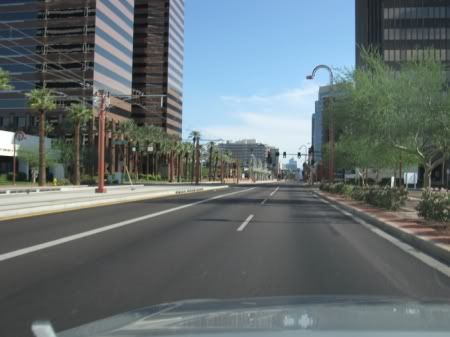 I'm driving south on Central Avenue toward downtown. The median now boasts a light rail line, which runs north and east from downtown. Phoenix is now a very respectable metropolitan area, complete with a very extensive freeway network (most of which did not even exist 20 years ago) and a different demographic mix. The Arizona of Barry Goldwater and John McCain is being replaced by the Arizona of Janet Napolitano. Of course, with the population boom, the negatives also start to seep in, including numerous camera-based speed traps on the freeways which did not exist the last time I came this way in 2006. I also found that the downtown area remains quite dead on a weekend like this, unlike downtowns of other, older cities like San Francisco and Seattle.
I'm driving south on Central Avenue toward downtown. The median now boasts a light rail line, which runs north and east from downtown. Phoenix is now a very respectable metropolitan area, complete with a very extensive freeway network (most of which did not even exist 20 years ago) and a different demographic mix. The Arizona of Barry Goldwater and John McCain is being replaced by the Arizona of Janet Napolitano. Of course, with the population boom, the negatives also start to seep in, including numerous camera-based speed traps on the freeways which did not exist the last time I came this way in 2006. I also found that the downtown area remains quite dead on a weekend like this, unlike downtowns of other, older cities like San Francisco and Seattle.I was dehydrated and exhausted, and by the time I was marching through Arizona Mills outlet mall in Tempe, I was about to lose it. I did finish with a nice Sonic hamburger back in Scottsdale - my first ever.
I'm done with Phoenix this time, and will return to California tomorrow. I do hope to be back on a cooler day, perhaps with a bit more time to spare, and extending my trip to Tucson and other areas too.